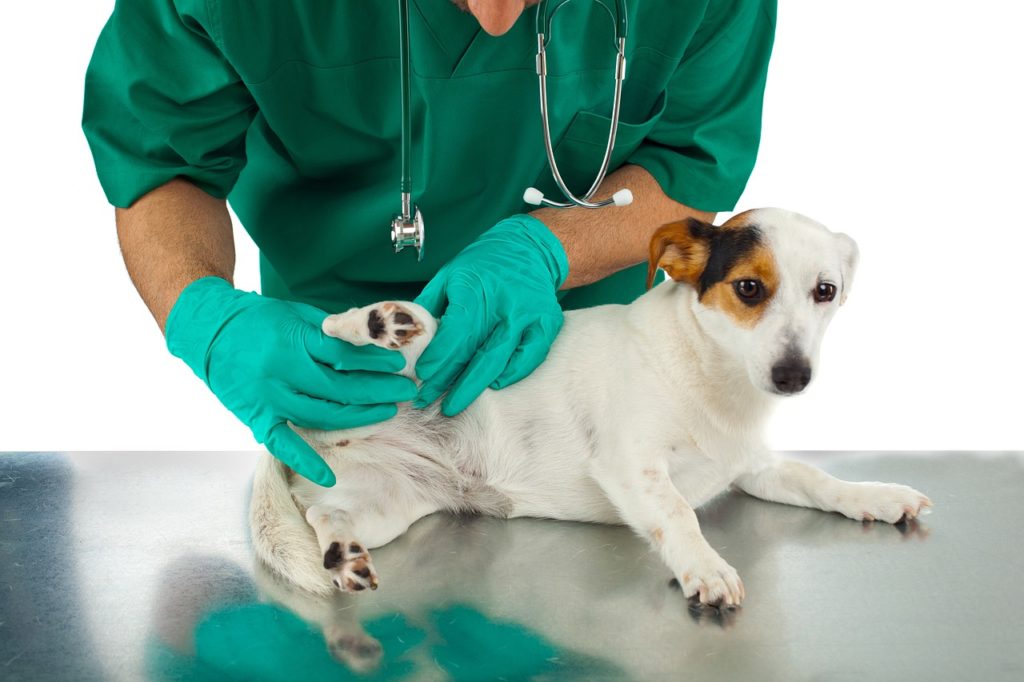There are a lot of flea treatments out there for your pets, such as flea powders, flea collars, spot-on treatments, and natural remedies like lemon sprays. But it’s not always that simple… Some pets may have adverse reactions to flea treatments. So, here is everything you need to know about any possible unpleasant reactions.
Adverse reactions to flea treatments
Flea treatments are generally safe for pets as long as they are FDA-approved. But a small number of pets can have negative reactions to these flea treatments. Here are the four reactions you should look out for.
1. Contact dermatitis
Contact dermatitis is a progressive inflammatory response to a flea treatment, usually from one that is applied topically, like spot-on treatments. It is characterized by irritation and redness in the area where the treatment has been applied.
The worst thing about contact dermatitis is that it doesn’t occur immediately. It can take several hours to develop, with usually 12 to 24 hours for the condition to fully mature. It often develops after several applications of the treatment. But it’s not that uncommon for the condition to develop on first-time applications.
The only good thing about contact dermatitis is that it’s very uncommon for pets to get this condition from flea treatments. But as a safety measure, you should heavily observe your pet for signs of irritation and redness for an hour or so after applying the flea treatment.
2. Paresthesia
Paresthesia is a skin reaction characterized by burning, prickling, itching, or tickling of the skin. Pets can suffer from this condition if the flea treatment you have applied to them contains pyrethroids, which are quite common among flea treatments. Humans can suffer from pyrethroid paresthesia too.
Pets who are experiencing this condition can show signs of agitation and discomfort as they thrive to relieve themselves of the sensation in their skin. Some pets also react differently. They become anti-social and quiet.
The good news about paresthesia is that it triggers within 30 minutes or so after applying the flea treatment. You will be able to react immediately and save your pet from the terrible skin sensations it may feel.
3. Neurologic adverse events
According to the FDA, pets who are being treated with flea treatments in the isoxazoline class can suffer from neurologic adverse events like ataxia, muscle tremors, and seizures. These are the products in the isoxazoline class:
- Bravecto
- Credelio
- Nexgard
- Simparica
- Revolution Plus
Take note that these products are approved and regulated by the FDA. They are safe and effective against flea infestations. It’s just that a small number of pets react negatively to them. It’s a good thing to know when you and your veterinarian are looking for the right flea treatments for your pet.
4. Digestive problems
Among flea treatments, those that are applied topically cause the most problems. But those that are taken orally can present problems too. Most of the time, the problems associated with oral flea treatments are digestive in nature.
Pets can experience abdominal cramps, bloating, diarrhea, drooling, vomiting, and even paralysis. But oral flea treatment side effects are very rare. This is because most oral flea treatments need a prescription. Veterinarians heavily check pets first before prescribing a treatment, so the risk of such problems are minimal.

Things to do in case of adverse reactions
If you suspect that your pet is reacting negatively to your flea treatment, you should be proactive. Here are things you can do.
1. Remove the treatment as soon as you can
Remove the product that is causing the adverse reaction. If it is a flea collar, take it off your pet’s neck immediately. If it is a topical treatment like a spot-on treatment, wash it off with mild soap and water. Don’t let your pet get in contact with the treatment again.
2. Consult a veterinarian
If your pet has fleas, the best way to get rid of the fleas is by consulting a veterinarian. This way, you can avoid negative reactions as much as possible. The veterinarian can accommodate the specific needs of your pet, like its medical history and sensitive skin.
But if you have not consulted a veterinarian and just used an over-the-counter medication and saw signs of negative reactions, it’s not too late. Go to the veterinarian and present your pet’s case. The veterinarian will treat the negative reactions and may suggest other flea treatments.
3. Try a different flea treatment
Reactions to flea treatments can just be mild and annoying, such as skin irritations. But they can also be dangerous, just like neurologic adverse events. You shouldn’t take your chances. If your pet reacts negatively in any way to a flea treatment, ditch that product and try to look for something else that has different active ingredients.
The importance of consulting a veterinarian comes to mind again.
4. Observe your pet
Once you have applied a new flea treatment to your pet, observe it heavily for the next few hours. Watch out for the signs of negative reactions. Does it look like it is trying to relieve an itch? Is it vomiting? Is there a sudden change in its temperament?
If you think that your pet is having a bad reaction to your flea treatment, consult a veterinarian as soon as you can. You don’t know how serious the reaction is.

FDA-approved treatments are generally safe
Generally, there is no need to worry about flea treatments as long as they are approved by the FDA. Only a small number of pets react negatively to flea treatments. With that said, you should not take adverse reactions to flea treatments lightly. The worst cases can be life-threatening.
Here are some quick tips to ensure the effectiveness and safety of flea treatments:
- Make sure you are using FDA-approved products. Products are heavily scrutinized by the FDA before they are approved for sale. Only buy FDA-approved products.
- Consult a veterinarian. Sure, there are a lot of articles online that will help you choose the right flea treatment for your pet. But nothing beats professional help. Consult a veterinarian to know the best flea treatment for your pet’s specific case.
- Read the instructions and follow them diligently. Flea treatments, even if they are approved by the FDA and prescribed by a veterinarian, will be ineffective and unsafe if you don’t follow their proper application. Read the instructions on their labels and follow them without question.
Flea treatments are here to help your pets, not cause further harm. With enough care and effort on your part, they are your best bet to get rid of fleas.

